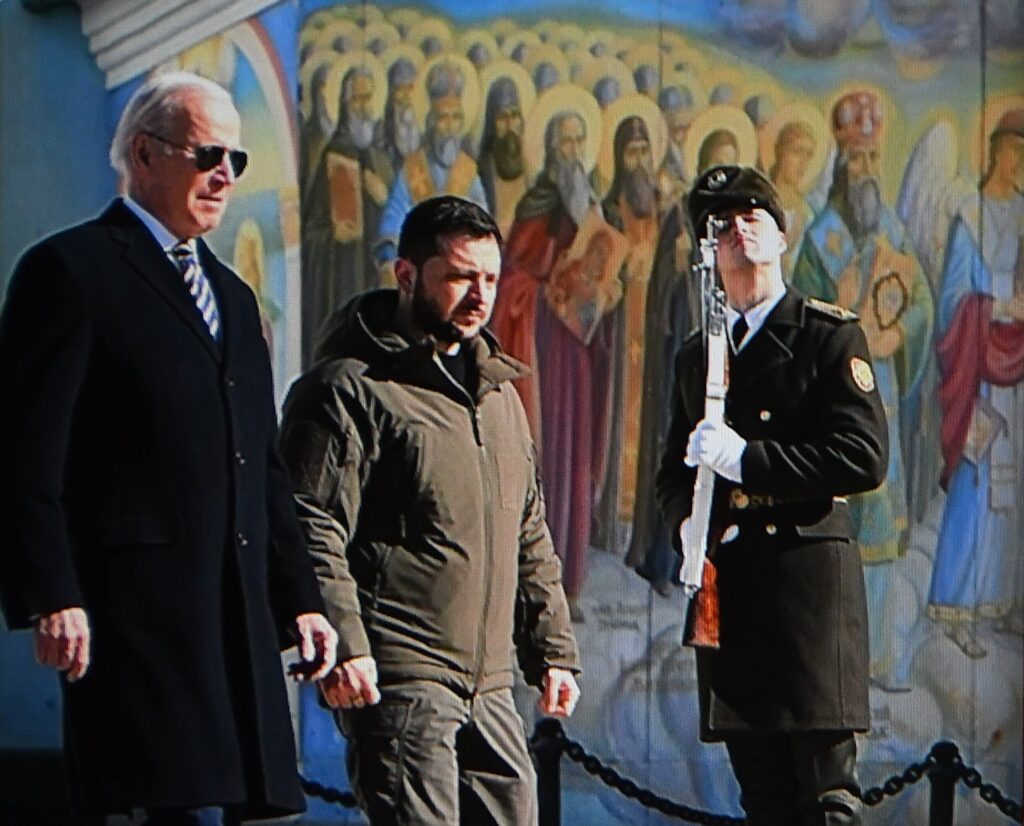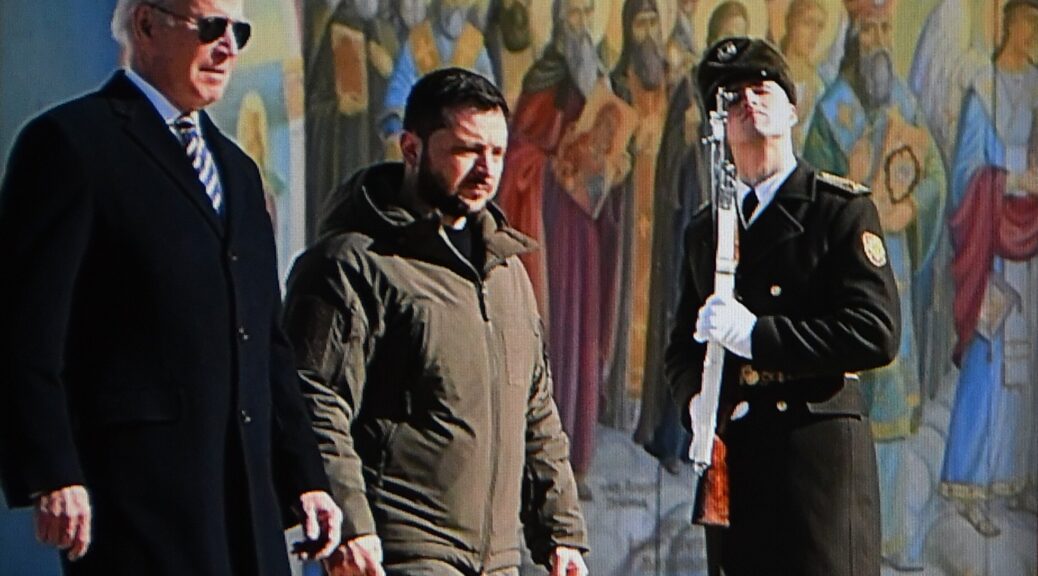
Just days before the one-year anniversary of Russia’s invasion of Ukraine, President Joe Biden made a historic visit to Ukraine and then delivered a speech in Warsaw recommitting United States, NATO and allied support for Ukraine, in an existential battle for freedom, democracy and sovereignty against Putin’s unprovoked, brutal assault. Here is a fact sheet from the White House listing the past year’s efforts to support Ukraine, which like David and Goliath, has managed to stand up to one of the strongest military forces on earth:
Nearly one year ago, Russia launched its unjust, brutal assault against Ukraine. Putin’s invasion was a test of Ukraine’s commitment to freedom, and a test for America and the world. Putin sought to subjugate Ukraine, but the free people of Ukraine stood strong—bravely defending their sovereignty and democracy. The United States, alongside our allies and partners, did not hesitate to stand with them.
Over the last year, the United States has provided critical support to the people of Ukraine, working in close coordination with the government of Ukraine to get them what they need. President Biden has spoken regularly with President Zelenskyy, hosting him at the White House and visiting Kyiv to send powerful messages of the United States’ unwavering support. We have led the world in providing security assistance—from the Javelins that halted the Russian tanks assaulting Kyiv, to the air defense systems that have intercepted Russian strikes against Ukraine’s critical infrastructure, to the armored vehicles that Ukraine needs for the next phase of this conflict. We also stepped up to provide financial and humanitarian assistance—helping Ukrainians maintain access to fundamental services, like healthcare and heat, as they fight for their liberty and sovereignty.
The United States has not acted alone. Since first exposing Russia’s plans to launch this invasion, we ensured that Ukraine’s resilience has been matched with global resolve. We rallied the international community to speak out and stand against Russia’s brutal war, including at the United Nations, where the world has repeatedly and overwhelmingly voted to condemn Russia’s aggression. We have led unprecedented efforts to isolate and impose costs on Russia—including the largest coordinated sanctions and export control actions taken against a major economy. In response to the global economic disruptions caused by the Kremlin, we have launched initiatives that have stabilized energy markets and food supplies. And we supported our partners as they opened their homes and communities to millions of Ukrainians seeking refuge.
One year ago, Putin thought he could quickly topple Ukraine. He thought he could divide our allies and partners. He was wrong. Ukraine still stands. The international coalition in support of Ukraine is stronger and more united than ever. And President Biden’s visit to Kyiv yesterday sent a clear and powerful message to the world: we remain committed to standing with the people of Ukraine for as long as it takes.
Actions we have taken to support Ukraine and hold Russia accountable over the last year include:
Security Assistance
Over the past year, the United States and our allies and partners provided critical security assistance that made a real difference on the battlefield, and helped the people of Ukraine defend their country from Russian attacks and advances.
At the start of the war, the anti-armor and anti-air systems we provided—like the 8,000 Javelin and 1,600 Stingers—enabled Ukraine to win the Battle for Kyiv. The artillery and ammunition we have sent—such as the 160 howitzers and 38 High Mobility Artillery Rocket systems—enhanced Ukraine’s ability to defend its territory in the Donbas region and launch successful counteroffensives in Kharkiv and Kherson, reclaiming hundreds of kilometers of territory and liberating towns and villages subjected to unimaginable Russian brutality. The air defense systems and counter-drone capabilities that we provided help Ukraine protect its people and infrastructure against continued Russian attacks. The armored capabilities we are sending—including 109 Bradley infantry fighting vehicles and tanks—will prepare Ukraine for future counteroffensives and help Ukraine adapt to changing conditions on the ground and defend against future Russian assaults.
We have provided more than one million rounds of artillery ammunition; more than 100,000 rounds of 125mm tank ammunition; and 100,000 rounds of small arms ammunition. We have provided helicopters; Unmanned Coastal Defense Vessels, and counter-UAV systems and equipment. And the Departments of Defense and State have released a plan to prevent and counter the potential of illicit diversion of weapons and equipment.
Working with European partners and Ukraine, the United States also launched the Ukraine Defense Contact Group—a coalition of 50 partner nations that has enhanced our coordination of security assistance deliveries to help the people of Ukraine as they continue to defend themselves against Russia’s unjust and unprovoked assault. Together, members of this group already committed $50 billion security assistance, including nearly 700 tanks and thousands of other armored vehicles, more than 1000 artillery systems, more than two million rounds of artillery ammunition, more than 50 advanced multiple rocket launch systems, and anti-ship and air defense systems.
A comprehensive list of security assistance is available here.
Humanitarian Assistance
When Russia launched its invasion, the United States responded quickly to the humanitarian crisis in Ukraine—providing more than $1.9 billion to Ukrainians in need of assistance, including more than 13 million people forced to flee their homes.
We brought together partners across the United Nations agencies and non-governmental organizations to address Ukrainian’s critical needs—including food, safe drinking water, shelter, and emergency health care. When winter approached and Putin turned his assault to critical infrastructure, a U.S.-led coalition provided supplies to restore emergency power and heat across the country. In addition to welcoming over 267,000 Ukrainians who have been forced to flee their homes to the United States and creating the Uniting for Ukraine program, we have provided $340 million in refugee assistance to our European partners who continue to host millions of Ukrainians, representing the largest population outflow in Europe since World War II.
A comprehensive list of humanitarian assistance is available here.
Democracy, Human Rights, and Anti-Corruption Assistance
To defend human rights in Ukraine and its neighbors, President Biden launched the European Democratic Resilience Initiative (EDRI) in March 2022. Through EDRI, we have provided nearly $220 million for Ukraine to support media freedom and enable Ukrainian media outlets to continue operating during the war, to counter disinformation, increase the safety and security of activists and vulnerable groups, strengthen democratic and anti-corruption institutions, and support accountability for human rights abuses and violations of international law.
Holding Russia Accountable
Justice and accountability are central pillars of the United States’ policy on Ukraine. Russia chose this war, and the United States and our partners are holding it accountable for its attacks and atrocities against the people of Ukraine — ensuring that perpetrators, human rights violators, and war criminals are brought to justice.
Based on a careful analysis of the law and available facts, the Secretary of State recently determined that members of Russia’s forces and other Russian officials have committed crimes against humanity in Ukraine.
Working with partners, we have supported Ukrainian domestic authorities, international efforts, and strategic litigation to ensure that Russia’s crimes do not go unpunished. Along with many of our allies and partners, we imposed new sanctions on those engaged in human rights abuses and exercising illegitimate authority in occupied areas of Ukraine, including proxy authorities, military units, and those involved in the forced deportation of children.
The United States has also imposed expansive visa restrictions on members of the Russian military and others committing human rights abuses related to Russia’s war. The United States continues to support a range of international accountability mechanisms—including the UN Independent International Commission of Inquiry on Ukraine, the UN Human Rights Monitoring Mission in Ukraine, the Organization for Security and Cooperation in Europe’s Moscow Mechanism, and the Joint Investigative Team on Ukraine.
Economic Measures Against Russia
The United States and over 30 allies and partners developed the largest set of sanctions and export control actions ever imposed on a major economy. These actions are disrupting Russia from accessing critical inputs and advanced technologies — undercutting its ability to fund and fight its unjust war.
The United States has implemented or expanded more than 2,000 sanctions listings and more than 375 export control Entity Listings, including major state-owned enterprises and third-country actors supporting Russia’s war machine. We imposed sanctions on Russia’s largest financial institutions and imposed increasingly expansive restrictions on military and industrial goods that could support Russia’s defense industrial base. As a result, Russia has been forced to turn to rogue regimes to try to source weapons and equipment because of their inability to make enough parts to resupply Putin’s war at home. Additionally, Congress has revoked Russia’s permanent normal trade relations status — removing Russia’s privileges in international trade and increasing tariffs on hundreds of Russia products imported into the United States.
These sanctions and export controls will cut even deeper into Russia’s economy as time progresses. And at the same time, our economic measures have been specifically designed to shield low- and middle-income countries from their impact — including protecting the exports of food, allowing the provision of humanitarian assistance, and carving out agriculture, medicine, and energy payments from our sanctions.
Energy Assistance and Security
When Russia attacked Ukraine’s energy infrastructure, trying to use winter as a weapon against the Ukrainian people, the United States and its allies and partners provided energy assistance: restoring power, heating homes, and enabling the people of Ukraine to focus on the defense of their sovereignty.
Together with our allies and partners, we provided critical electricity equipment to help Ukraine make emergency repairs to its power system and strengthen the stability of Ukraine’s grid in the face of Russia’s targeted attacks. We also worked with Ukraine to advance its energy transition and build a system decoupled from Russian energy. And we worked to stabilize global energy markets, limit Russia’s revenue, and blunt the impacts of Russia’s war on energy security. Through the U.S.-EU Task Force on Energy Security, we ensured Europe had enough gas for the winter. The United States also released 180 million barrels of oil from the Strategic Petroleum Reserve, ensured international energy payments continue to flow under our sanctions, and implemented a G7+ price cap on seaborne Russian oil and petroleum products.
We also took steps to reduce nuclear risks posed by Russia’s reckless actions at and around Ukraine’s nuclear power plants to support energy infrastructure, including through training for emergency responders, radiation sensor monitoring, and the provision of emergency diesel fuel and other nuclear safety supplies.
Economic Assistance
The United States has disbursed $13 billion in grant financing for budget support for Ukraine —and will soon begin disbursing another $9.9 billion that Congress recently approved — to ensure the Ukrainian government can continue to meet the critical needs of its citizens and provide basic services as it confronts Russia’s continued aggression. Through the World Bank’s Public Expenditures for Administrative Capacity Endurance mechanism, the United States has used it to provide budget support on a reimbursement basis — ensuring funding is disbursed to Ukraine only after expenses have been verified.
In its leadership role in international financial institutions, the United States has also worked closely with the International Monetary Fund, the World Bank Group, and the European Bank for Reconstruction and Development to support Ukraine — including to strengthen energy security, food security, and support for vulnerable populations and internally displaced persons across the country. Together with the G7, we have launched the Multi-agency Donor Coordination Platform for Ukraine, to enhance our coordination of economic support for Ukraine’s immediate financing needs and future economic recovery and reconstruction efforts.

